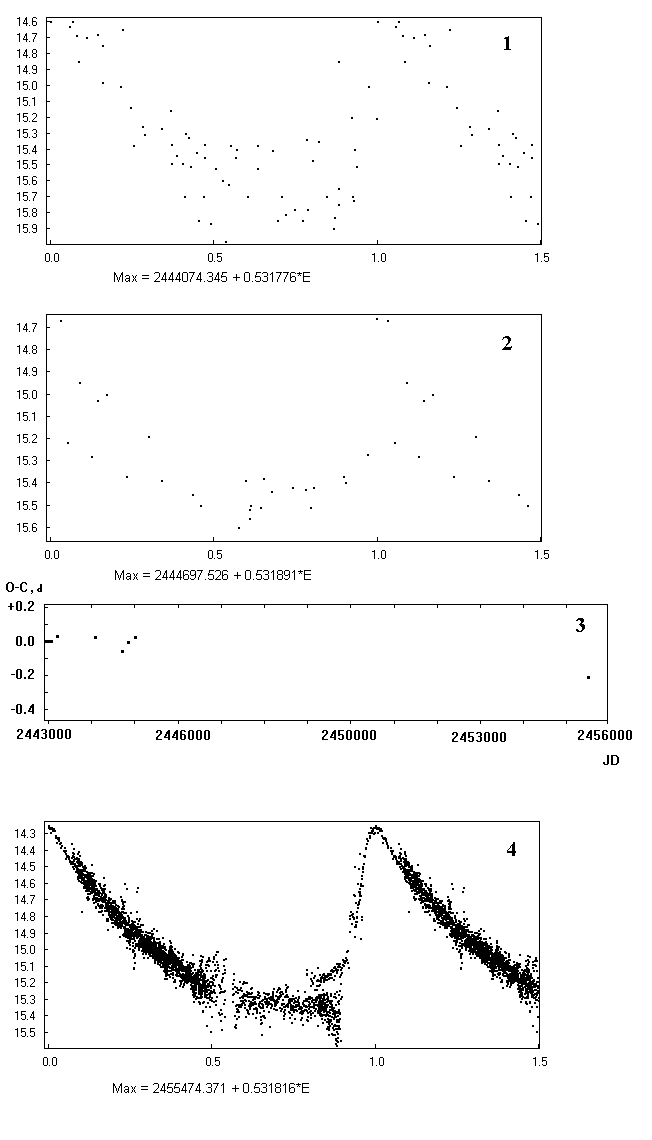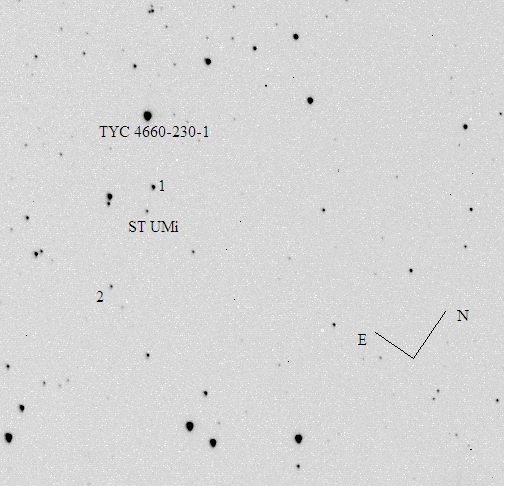| Article in PDF |
"Peremennye Zvezdy", Prilozhenie, vol. 11, N 6 (2011) |
Period Variations of the RR Lyrae Variable ST Ursae Minoris
I. Sergey#1, I. Bryukhanov#2
#1. Molodechno, Belarus;
#2. Minsk, Belarus
#2. Minsk, Belarus
| ISSN 2221–0474 |
Received: 16.10.2010; accepted: 18.02.2011
(E-mail for contact: seriv76@tut.by; betelgeize_astro@mail.ru)
| ||||||||||||||||||||||
Remarks: |
| The variability of ST UMi was discovered by V.P. Goranskij and announced by Veremchuk
(1982). It was found to be an RRAB star varying between 14m.0 and 15m.8
(pg), with the light elements Max hel = 2444074.380 + 0d.5317771 x E,
from plates of the Moscow collection (JD 2443026–2444261).
One of us (I.B.) re-estimated the Moscow plates already used by Veremchuk plus a number of additional plates (a total of 101 measurements, JD 2440361–2447208). His estimates for the plates taken before JD 2444261 (66 measurements) correlate with those by Veremchuk; Fig. 1 is plotted for the light elements Max hel = 2444074.345 + 0d.531776 x E. However, his 35 measurements for JD 2444697–2447208 are better represented with the light elements Max hel = 2444697.526 + 0d.531891 x E (Fig. 2). These late photographic observations also suggest Blazhko effect because of the large scatter at maximum. One of us (I.S.) obtained CCD observations of ST UMi with a 200-mm Newton 1:5 telescope, equipped with a Mead DSI Pro CCD camera, at a private observatory near the city of Molodechno (Belarus). A total of 2827 unfiltered frames were taken on JD 2455297–2455474. Our photometry made use of the Maxim DL software with full calibration of images; for calibration, we used red magnitudes from the USNO-A2.0 catalog (Monet et al. 1998). Though the O–C diagram (Fig. 3) plotted with the light elements from Veremchuk (1982) does not show a too large deviation of the data point corresponding to our observations from zero, a good light curve with our observations cannot be obtained with Veremchuk's light elements. Figure 4 exhibits our observations plotted with the light elements Max hel = 2455474.371 + 0d.531816 x E. We searched for periods using the WinEffect code developed by V.P. Goranskij. We conclude that the RRAB variable ST UMi experiences rather strong period observations. Better coverage with observations is needed to study these variations in more detail. Acknowledgements: Thanks are due to T. Avilin for his assistance. |
| References: |
| Monet, D., Bird, A., Canzian, B., et al., 1998, USNO-A2.0, A Catalog of Astrometric
Standards (U.S. Naval Observatory, Washington, DC), Centre de Donnees Astronomiques
de
Strasbourg, I/252
Veremchuk, V.S., 1982, PZP 4, 239 |
Light Curve
1. Photographic observations by I.S. Bryukhanov (2440361–2444261). 2. Photographic observations by I.S. Bryukhanov JD 2444697–2447208). 3. The O–C diagram plotted using the light elements from Veremchuk (1982). 4. The light curve for CCD observations by I.M. Sergei. See text for light elements used to plot each of the light curves. Finding Chart 
1.USNO-A2 1725-612696: R=14.2, B=14.7. 2.USNO-A2 1725-609354: R=15.1, B=16.0. Data Source |